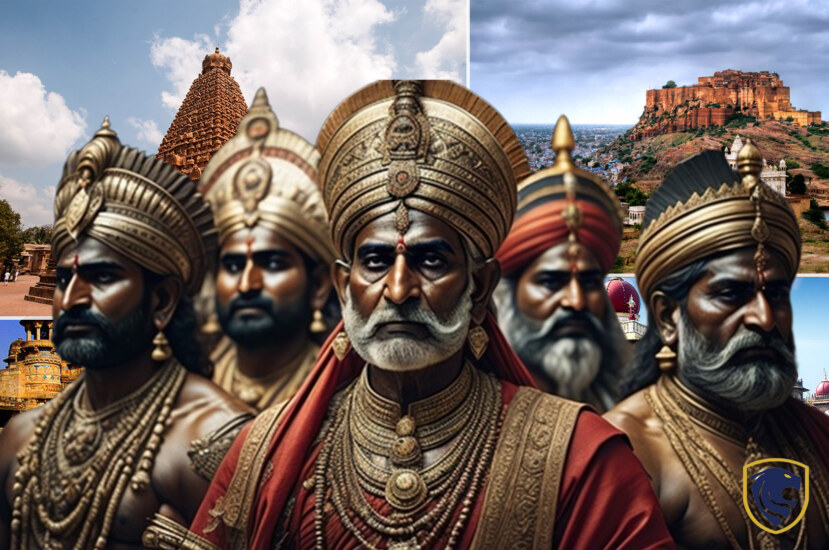India had been the cradle of great empires in world history. Even though the empires have fallen many years back, remnants of those empires are proof of their greatness, and they have left indelible legacies.
Mauryan Empire
The Mauryan Empire was established around 321 BCE, during the reign of Chandragupta Maurya.
The Mauryan empire constituted Central and Northern India and some areas of contemporary Iran. Before Chandraguptha Mauryan grabbed the power, the North-West Indian subcontinent was under Alexander the Great. After the demise of Alexander in 323 BCE, he took advantage of the power void that was created. He invaded Magada and created the Mauryan empire with the mentorship of Chanakya. He acquired more lands for the empire through force and by forming alliances.

Mauryan Empire
His son Bindusara became the empire after his demise. The third empire Ashoka is considered the greatest monarch in Indian history. He further enlarged his empire. The Kalinga war was a turning point as it transformed him from ‘Chandashoka’ to Dharmashoka. The Kalinga War resulted in huge bloodshed, so King Ashoka was filled with contrition. However, later he embraced Buddhism and upheld values like nonviolence, and compassion and halted the enlarging of his empire. He sent Buddhist missionaries to other countries in order to introduce Buddhism to people in those countries.
After the passing of King Ashoka, the downfall of the Mauryan empire began.
Decline
The successors of the Mauryan empire who ruled for the next 50 years were weak. They did not retain strong authority. The empire got shrunk gradually. General Pusyamitra Sunga killed Brihadrathna Maurya in a coup ending the Maurya dynasty and subsequently, the Sunga dynasty was founded.

Mauryan Empire
There are other contributory factors to the fall of the Mauryan Empire. After the demise of Ashoka, Mauryan Empire was no more invincible. The successors of the Mauryan Empire had to face foreign invasions. Further, in 180 BCE Greece invaded the north-western Indian territories and established the Indo-Greek kingdom. Due to the vastness of the empire, it was difficult to carry out administrative activities and rule from a central point. As a result, the provinces became independent and there were constant internal revolts. So, the Mauryan empire ended around 180 BCE.
Gupta Empire
The start of the Gupta empire dates back to the 44th century CE and it ended in the late 6th century CE. Its pinnacle is from 319 to 467 CE and they could rule many of the parts of the Indian subcontinent. Moreover the era of the ‘Gupta Empire’ is recounted as the ‘Golden Age’ of India.
It was a wealthy family in Magadha or Prayaga that incepted the Gupta empire. This family also became a prominent family and ultimately became rulers of Magadha. Chandra Gupta 1 was the initiator of the Gupta empire.

Gupta Empire
In the subsequent years, they enlarged their territory through the means of military advances or matrimony. Chandra Gupta’s son Samudra Gupta ascended to the throne in around 330. Moreover, he chose Pataliputra as the capital, so it became the administrative base. He further expanded the territory. He captured a number of smaller kingdoms towards the east which is Myanmar now. Territories in the north up to Nepal and the entire Indu Valley region towards the west were under the Gupta Empire.
The remnants from this period show that there were accomplishments in the fields of literature, music, art, architecture, and philosophy. For instance, Dashavatara Temple in Deogarh UP was built during Gupta Empire. It is one of the surviving Hindu temples of the era, and it showcases the marvelous architecture that existed in that era.
The downfall of the Gupta dynasty
Gupta Emperors had to face multiple attacks from both foreign and native forces.

Gupta Empire
Foreign Invasions
As for foreign invasion, the invasion of Huns was detrimental to the Gupta Empire. Kumaragupta I was the first king to face an invasion by Huns. Huns constituted a nomadic group of people who dwelled in central Asia, Eastern Europe, and the Caucasus. In 480, they waged a war against the Gupta Empire. They could conquer the tributary states in the northwest and, later got the control of territory that the Gupta empire controlled. Huns could gain power, namely in Gandhara, Punjab, Gujrat, and Malwa by the sixth century. As a result, the Gupta Empire was limited to a small territory.
And Gupta territory was split into regional states in 550CE.

Foreign Invasions
Internal Revolts
They lacked a well-armed, large army during this time period. The Gupta emperors had to face internal threats as well. For instance, the Gupta emperors had to compete with Vakatakas.
Yashodharman hailed from Malwa which was a region in Central India and he was the ruler of Malwa in the early years of the sixth century. Mandsaur pillar inscriptions give evidence of Yashodharman’s conquest of many parts of the Indian subcontinent between 530 to 540 AD.

Skandagupta era
These revolts weakened the Gupta empire more.
Rulership
Another reason for the downfall was weak rulers. During the period of Skandagupta who was the grandson of Chandragupta II, the empire lacked the resources and wealth to rule. And Skandagupta was known for his short-tempered and vindictive behaviour. He was an unpopular ruler. Gupta regions became further weak due to internal conflicts among royal families. The dissolution of power among regional kingdoms diminished the power of the Gupta Empire.
Economy
There was turmoil due to the weak economic situation. The trade in Gujrat was gradually weakened. In the early period of the Gupta Empire, silk production flourished. In 473 AD, the base of Silk Weavers was relocated to Malwa from the city of Gujarat. Also, according to historic data, their occupation was non-productive and ineffective at the time. It depicts that there was not much demand for produced clothes. And it reflects the weak economy of that period.
The profits they enjoyed from the trade of Gujarat gradually dissipated. During the prosperous times, Gupta emperors used coins to do trade, which was made of gold. During the mid of the fifth century, the emperors made endeavours to keep their gold currency in use. But the use of authentic gold for currencies dropped towards the end.

Economy
Other Reasons for the Fall
There are other reasons recorded for the fall of the Gupta Empire. They failed to establish land reforms.
The crop failure in the era contributed to the weak economy. Natural calamities also impaired and impacted the economy and living conditions of people. There were floods that were devastating.
In this background, the emperors showed fervour for Buddhism rather than Hinduism. It is said to be a reason for the collapse of the Gupta empire as they paid less attention to military conquests, influenced by Buddhist values.

Other Reasons for the Fall
In the mid-sixth century, the Gupta dynasty came to a halt. Tormana was the first potentate of the Huns. He invaded northern India up to Malwa. His son Mihirkula demolished the Gupta empire and ruled for thirty years.
Mughal Empire
Babur who was a Timurid prince from Central Asia, gained rulership in Kabul and later conquered much of northern India. His Indian invasion started with the Panipat War in 1526. Afterward, many Mughal emperors ruled most of the subcontinent including modern-day Pakistan, Afghanistan, and Bangladesh till 1707. Also, they ruled hilly parts of the Deccan Plateau in South India.
After the conquest of Indian territory, they didn’t repress the people and the culture they ruled. They allowed the people and cultures to prosper. The new administrative practices that were introduced equalized all and were efficient. Also, agricultural taxes were the main source of income. The peasants and artisans were paid back in silver coins, so they could enter larger markets.

Mughal Empire
The 17th century was a peaceful period as India grew prosperous economically. Furthermore, there was a high demand for raw and finished products from Europeans in the Indian Ocean which generated greater wealth in Mughal courts.
Agra Fort, Fatehpur Sikri, red fort, Humayun’s tomb, Lahore Fort, Shalamar Gardens, and Taj Mahal which are included in the UNESCO world heritage, bear evidence of the contribution of the Mughal Empire for art.
Downfall
Their decline started in 1707, but nominal rulership continued till the Indian Rebellion of 1857. Aftermath of the rebellion, the British Raj formally wound up the Mughal Empire.
The Mughal Empire was not on alert nor prepared to face the European invaders. They could not sustain the military prowess of Britain. It is said they neglected governance and focused on other external matters like choosing beautiful costumes. For example, the Afghan Lodi Sultans lost their power due to preoccupation with personal pleasures. The prosperity, in the beginning, faded away. They lost their financial power.

Downfall
In the mid-nineteenth century, major parts of the Mughal Empire were under the control of the British via a series of treaties and alliances. Queen Victoria was declared the empress of India and got control of India. Moreover, by the 20th century, the Indian subcontinent was under British administration.
There are a few descendants of the Mughal emperor at present. They live in Delhi, Kolkata, and Hyderabad. Most of them carry the name ‘Temur’.




